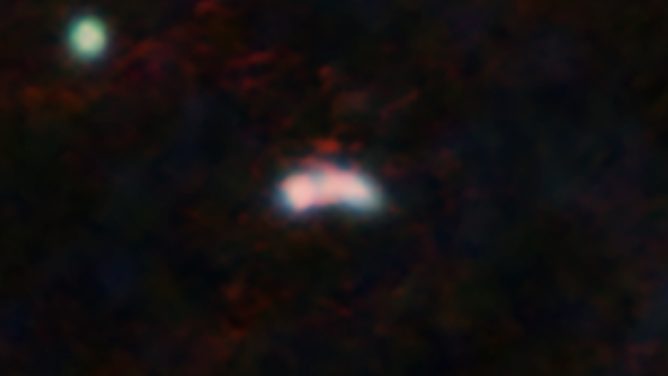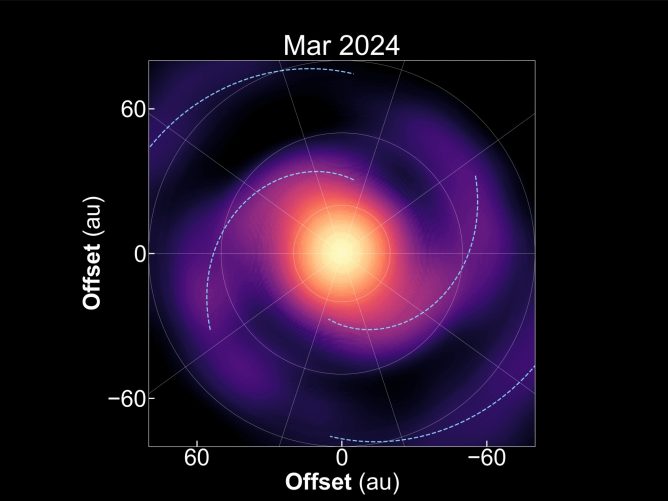2021.03.29
Stellar Eggs near Galactic Center Hatching into Baby Stars

ALMA pseudo-color composite image of the gas outflows from baby stars in the Galactic Center region. Gas moving toward us is shown in blue and gas moving away from us is shown in red.
Credit: ALMA (ESO/NAOJ/NRAO), Lu et al
“It is like hearing babies’ cries in a place we expected to be barren,” says Xing Lu, an astronomer at the National Astronomical Observatory of Japan. “It is very difficult for babies to be born and grow up healthily in an environment that is too noisy and unstable. However, our observations prove that even in the strongly disturbed areas around the Galactic Center, baby stars still form.”
Stars are formed in cosmic clouds gathered by gravity. If something interferes with the gravity driven processes, star formation will be suppressed. There are many potential sources of interference in the Central Molecular Zone (CMZ) of the Milky Way, located within a radius of 1000 light-years from the Galactic Center. Examples include strong turbulence which stirs up the clouds and prevents them from contracting, or strong magnetic fields can support the gas against self-gravitational collapse. In fact, previous observations indicated that star formation here is much less efficient; with the exception of one active star forming region called Sagittarius B2 (Sgr B2).
Lu and his colleagues used ALMA to tackle the mystery of suppressed star formation in most of the CMZ. The target regions contain an ample amount of gas, but no star formation has been expected. Contrary to the traditional picture, the team discovered more than 800 dense cores of gas and dust particles in the CMZ. “The discovery leads to the question of whether they are actually ‘stellar eggs’ or not,” says Lu. To look for telltale signs of star formation indicative of stellar eggs, the team again used ALMA to search for energetic gas outflows, which are like the birth cries of baby stars. Thanks to ALMA’s high sensitivity and high spatial resolution, for the first time, they detected 43 small and faint outflows in the clouds. This is unambiguous evidence of ongoing star formation. It turned out that many baby stars were hiding in the regions that were thought to be unsuitable for stellar growth.
The small number of detected outflows is another mystery. Considering the fact that more than 800 “stellar eggs” have been found, the small number of “stellar babies” might indicate that the star formation activity in the CMZ is in the very early phase. “Although a large number of outflows might be still hidden in the regions, our results may suggest we are seeing the beginning of the next wave of active star formation,” says Lu.
“Although previous observations have suggested that overall star formation rates are suppressed to about 10% in the giant molecular clouds in the Galactic Center, this observation shows that the star formation processes hidden in dense molecular gas clouds are not very different from those of the Solar neighborhood,” explains Shu-ichiro Inutsuka, a professor at Nagoya University and a co-author of the research paper. “The ratio of the number of star-forming cores to star-less cores seems to be only a few times smaller than that in the Solar neighborhood. This can be regarded as the ratio of their respective lifetimes. We think that the average duration of the star-less core stage in the Galactic Center might be somewhat longer than in the Solar neighborhood. More research is needed to explain why it is so.”
The research team is now analyzing ALMA’s higher resolution observation data for the CMZ and aims to study the properties of the accretion disks around the baby stars which drive the gas outflows. By comparing with other star forming regions, they hope to better understand star formation in the CMZ, from clouds to protostars, and from chemistry to magnetic fields.
Paper information
These observation results were presented in Xing Lu et al. “ALMA Observations of Massive Clouds in the Central Molecular Zone: Ubiquitous Protostellar Outflows” in the Astrophysical Journal on March 16, 2021.
This research was supported by the Japan Society of Promotion of Science (JSPS) KAKENHI (No. 18K13589 & 20K14528), the Deutsche Forschungsgemeinschaft (DFG, German Research Foundation) through an Emmy Noether Research Group (grant number KR4801/1-1), the DFG Sachbeihilfe (grant number KR4801/2-1), the SFB 881 “The Milky Way System” (subproject B2), the European Union’s Horizon 2020 research and innovation programme via the ERC Starting Grant MUSTANG (grant agreement number 714907), and the National Science Foundation under Award No. 1816715.
The Atacama Large Millimeter/submillimeter Array (ALMA), an international astronomy facility, is a partnership of the European Organization for Astronomical Research in the Southern Hemisphere (ESO), the U.S. National Science Foundation (NSF) and the National Institutes of Natural Sciences (NINS) of Japan in cooperation with the Republic of Chile. ALMA is funded by ESO on behalf of its Member States, by NSF in cooperation with the National Research Council of Canada (NRC) and the Ministry of Science and Technology (MOST) and by NINS in cooperation with the Academia Sinica (AS) in Taiwan and the Korea Astronomy and Space Science Institute (KASI).
ALMA construction and operations are led by ESO on behalf of its Member States; by the National Radio Astronomy Observatory (NRAO), managed by Associated Universities, Inc. (AUI), on behalf of North America; and by the National Astronomical Observatory of Japan (NAOJ) on behalf of East Asia. The Joint ALMA Observatory (JAO) provides the unified leadership and management of the construction, commissioning and operation of ALMA.









